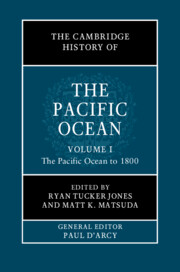Book contents
- The Cambridge History of the Pacific Ocean
- The Cambridge History of the Pacific Ocean
- The Cambridge History of the Pacific Ocean
- Copyright page
- Contents
- Figures
- Tables
- Contributors to Volume I
- Frontispiece
- General Editor’s Introduction
- Preface to Volume I
- Part I Rethinking the Pacific
- Part II Humans and the Natural World in the Pacific Ocean
- Part III Deep Time: Sources for the Ancient History of the Pacific
- Part IV The Initial Colonization of the Pacific
- 16 Pleistocene Voyaging and Maritime Dispersals in the Pacific
- 17 Early Maritime Navigation and Cultures in Coastal Southern China, Taiwan, and Island Southeast Asia, 6000–500 BCE
- 18 New Guinea’s Past: The Last 50,000 Years
- 19 Austronesian Colonization of the Pacific Islands, 1200 bce–1250 ce
- 20 Seafaring and Colonization in the Southern Ocean, 1000 ce–1850 ce
- 21 Polynesians in Central-South Chile
- Part V The Evolution of Pacific Communities
- Part VI Europe’s Maritime Expansion into the Pacific
- References to Volume I
- Index
17 - Early Maritime Navigation and Cultures in Coastal Southern China, Taiwan, and Island Southeast Asia, 6000–500 BCE
from Part IV - The Initial Colonization of the Pacific
Published online by Cambridge University Press: 11 November 2022
- The Cambridge History of the Pacific Ocean
- The Cambridge History of the Pacific Ocean
- The Cambridge History of the Pacific Ocean
- Copyright page
- Contents
- Figures
- Tables
- Contributors to Volume I
- Frontispiece
- General Editor’s Introduction
- Preface to Volume I
- Part I Rethinking the Pacific
- Part II Humans and the Natural World in the Pacific Ocean
- Part III Deep Time: Sources for the Ancient History of the Pacific
- Part IV The Initial Colonization of the Pacific
- 16 Pleistocene Voyaging and Maritime Dispersals in the Pacific
- 17 Early Maritime Navigation and Cultures in Coastal Southern China, Taiwan, and Island Southeast Asia, 6000–500 BCE
- 18 New Guinea’s Past: The Last 50,000 Years
- 19 Austronesian Colonization of the Pacific Islands, 1200 bce–1250 ce
- 20 Seafaring and Colonization in the Southern Ocean, 1000 ce–1850 ce
- 21 Polynesians in Central-South Chile
- Part V The Evolution of Pacific Communities
- Part VI Europe’s Maritime Expansion into the Pacific
- References to Volume I
- Index
Summary
Across the Asia-Pacific region, traditions of culture, history, and language were shaped through numerous sea-crossing migrations and inter-island contacts. The most remarkable sea-crossing events were the long-distance migrations made by the Austronesian-speaking populations. Austronesian was the most widespread language family in the world prior to 1500 ce, representing one of the most impressive records of human dispersal prior to the large-scale European expansions of the last few centuries.1 Through continuing research, multiple lines of evidence confirm the expansion routes of Neolithic farmers, starting about 3500–3000 bce from coastal southern China to Taiwan, onward to Island Southeast Asia, and continuing through 1300 ce into the eastern Pacific Islands. Seafaring abilities were the most crucial contributing factors in the long-distance migrations. This chapter starts with the Strait-crossing voyaging in the Palaeolithic context, and then reviews the evidence from the earliest parts of the Austronesian story of seafaring across the Asia-Pacific region, spanning from about 6000 bce in China through 500 ce in island and mainland Southeast Asia.
- Type
- Chapter
- Information
- The Cambridge History of the Pacific Ocean , pp. 381 - 405Publisher: Cambridge University PressPrint publication year: 2023



